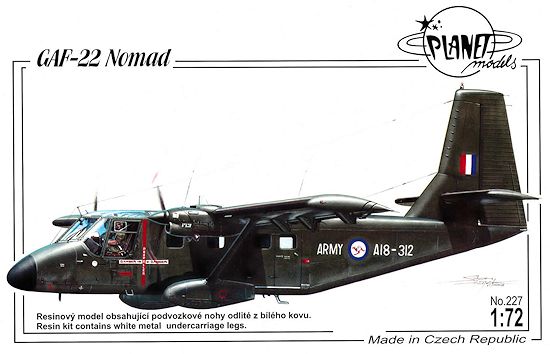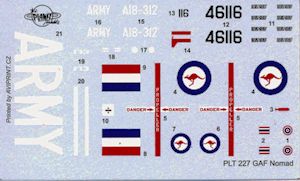
| KIT #: | 227 |
| PRICE: | $55.00 |
| DECALS: | Two One option |
| REVIEWER: | Peter Burstow |
| NOTES: |
Resin kit |

| HISTORY |
The Government Aircraft Factory N.22 Nomad first flew in 1971, a twin engine
STOL transport, it was developed to maintain production at GAF after the Mirage
contract was completed.
It
was a designed to seat 10 passengers or be converted for freight. It was widely
demonstrated and sold around the world.
172 were built and it was operated by a variety of military and civilian users.
| THE KIT |
 In
a strong top opening box, about 70 resin parts are enclosed in a segmented bag.
There are white metal undercarriage legs, two vacformed canopies and a piece of
clear card.
In
a strong top opening box, about 70 resin parts are enclosed in a segmented bag.
There are white metal undercarriage legs, two vacformed canopies and a piece of
clear card.
The instructions mention that weight will need to be added to the nose, there is
no mention of how much. This kit looks to be a real tail-sitter, but there is
not a lot of space for weight.
The vac-formed canopy is very thin and clear, with the panel
lines well marked. A spare is provided. A clear card is provided for the ten
small cabin windows, but these would be better done using white glue.
 The decals
have markings for two aircraft, an all green Australian Army example, and a
camouflaged plane of the Royal Thai Air Force. I had to adjust the brightness of
the decal scan to bring out the white markings.
The instructions are two sheets of A4, clearly printed in Czech and English,
with a short history, pictures of the parts and decals and a brief guide to
working with resin. An eleven stage photographic assembly sequence is provided,
with most of the parts placement clearly shown. A full page is devoted to full
colour profiles and decalling guides, with generic names for the paint colours.
The instructions are adequate to construct the model.
The decals
have markings for two aircraft, an all green Australian Army example, and a
camouflaged plane of the Royal Thai Air Force. I had to adjust the brightness of
the decal scan to bring out the white markings.
The instructions are two sheets of A4, clearly printed in Czech and English,
with a short history, pictures of the parts and decals and a brief guide to
working with resin. An eleven stage photographic assembly sequence is provided,
with most of the parts placement clearly shown. A full page is devoted to full
colour profiles and decalling guides, with generic names for the paint colours.
The instructions are adequate to construct the model.
| CONCLUSIONS |
A
bit expensive, but that's Czech resin. Recommended.
| REFERENCES |
http://aviation-safety.net/database/dblist.php?field=typecode&var=250%&cat=%1&sorteer=datekey&page=1
March 2013
If you would like your product reviewed fairly and fairly quickly, please contact the editor or see other details in the Note to Contributors.